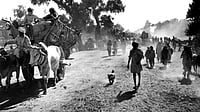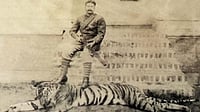The War Diary of Asha-San: From Tokyo to Netaji’s Indian National Army
Lt Bharati ‘Asha’ Sahay Choudhury
Translated by Tanvi Srivastava
Harper Collins India
Rs 599
The War Diary of Asha San is a coming-of-age story with a difference as it was written at a time when Netaji was collaborating with the Japanese for the cause of Indian Independence.
Asha was born in Japan and grew up speaking the language of the country. In fact, she wrote her diary in Japanese and translated it into Hindi much later. She had never seen India but her parents were important players in the Quit India movement and had taken refuge in Japan where they could be free from British oppression. Both of them were supporters of Netaji Subhash Chandra Bose and it was through an encounter with him that Asha’s life changed.
In her diary, Asha details life as it was in the Japan of World War II, where food was strictly rationed so that it could be sent to the Japanese military fighting the British and Americans and where the ordinary citizens were proud to make sacrifices for the cause of their nation. Given her upbringing, Asha found that sacrifice came easily to her. In her account, the tranquillity of Japanese country life, with touches of the poetry that she wrote, contrasts with the bombing raids by the Americans and constant anxiety about her father who moved through Singapore, Malaya, Thailand, and Burma (now Myanmar) —the ‘liberated zones’— that were under Japanese control, seeking adherents to Netaji’s cause and who was in danger of falling into British hands. Even her mother, Sati Sen, was coopted into carrying secret messages to bedridden Netaji in Calcutta before his famous escape.
Asha’s Diary gives us a very personal glimpse into what the Chinese would call ‘interesting times’. There are accounts of travels with her father by plane from island to island, sheltering in camouflaged huts, and later her own training in war and camouflage. While most readers are accustomed to looking at World War II and the Quit India movement from the point of view of those based in India, the Diary projects the Japanese as heroes and the Allied Powers as the enemy — quite naturally since the Japanese way of life was what Asha knew.
Asha gradually learned to read and write Hindi with the help of Panditji whom she met in Thailand, who told her that she needed to communicate in the language of her Motherland. While learning, she comments that she would much rather have done her BA in Japanese!
Divided into three parts, the Diary covers Asha’s growing up during 1943-45 and then moves onto the few short months in 1945 when she becomes part of the Rani of Jhansi Regiment and sees the destruction of her dreams with the defeat of the Indian National Army (INA) and Netaji’s eventual death, followed by her moving to India with her parents. It starts on a high note and gradually rides down from despair to ultimate acceptance.
The Diary shows the sensitivity and commitment of a young girl, who is fired by patriotism that makes her openly hostile to Americans who ask for cigarettes and British officers who offer her seats on a plane in a very teenage way. Since it is a diary, it skips from emotion to event and the translator, Tanvi Srivastava, conveys Asha San’s feelings and observations simply and directly — having had the benefit of working with a rough version of her grandmother-in-law’s Hindi text and the gallant Asha San herself in person. Srivastava also added additional information that she gleaned from Asha’s own later writings, including an English text which was half-begun, making this version of the diary authoritative indeed.
Most readers know the outcome of Netaji’s war, so what is interesting is reading Asha’s account of the event —the crash— which many still debate. She reacts as any teenager would — dismissing the news with a ‘Dhat’! Later, the whole story was told by her mother who was in Tokyo, who saw an ominous storm thunder through the sky when the event took place and who accompanied the ashes to the Renko-ji Temple.
The man whom the Japanese referred to as ‘a god of war’ remains one of the contemporary examples of the Indian fighting spirit, a sharp contrast to Mahatma Gandhi’s non-violence and its pliant obstinacy. This despite the fact that the INA movement that he spearheaded, with the hopes of many invested in it, ultimately proved a failure — half of the INA was wiped out. For Netaiji, after a triumphant beginning defeat followed defeat ending in the plane crash. For the remarkable Asha, who is now a nonagenarian, it meant finding home in a free India and the realisation that when all the wars are done, no one really wins. The spirit is all that there is.


























